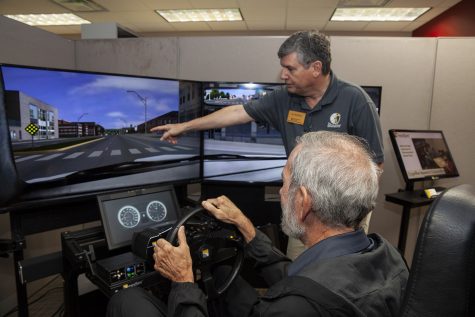University of Iowa researchers use implant to induce bone regeneration in diabetic patients
UI researchers are developing a multi-functional implant to improve the bone regeneration process in diabetic patients. People with diabetes are more likely to experience bone fractures that don’t heal properly.
The University of Iowa Pharmacy Building is seen during a media tour on Tuesday, Feb. 3, 2020.
September 2, 2020
Researchers at the University of Iowa are developing an implant that helps induce bone formation in patients with diabetes.
Aliasger Salem, UI College of Pharmacy Bighley Chair, is using a multi-functional implant composed of insulin, Vitamin D3, bone morphogenetic protein 2, and fibroblast growth factor to help those with Type 2 diabetics who have difficulties regenerating bones after fractures.
Compared to non-diabetic patients, Type 2 diabetic patients are more likely to experience bone fractures and have a harder time healing, Salem said.
John Femino, clinical professor at the UI Department of Orthopaedics and Rehabilitation, said patients with diabetes take longer to regulate their blood sugar. These high levels lead to dysfunction in the osteoblasts, which are cells that work to heal bones.
Femino added that Vitamin D3 is critical for patients to absorb calcium and facilitate these osteoblasts. Additionally, insulin works to restore bone fractures. Without this, he said, diabetics are known to heal worse and have higher levels of complications and infections.
Salem said he began developing the idea for a multi-functional implant with Femino’s help. Based on their previous work, Femino suggested looking at Vitamin D3 to help regenerate bones in diabetic patients.
From there, Salem began exploring different studies and his previous work on bone regeneration, looking at incorporating insulin that can stimulate osteoblasts. He said he asked himself how he could make bone regeneration better, which led him to look at creating a scaffold to induce bone growth.
“We call it multi-functional because we’ve got insulin to overcome the diabetic environment, and we’ve got Vitamin D3 to help with bone formation and bone regeneration,” the pharmaceutical expert said. “Then we’ve got our genes that promote preosteoblasts to convert into osteoblasts to form the bone.”
After developing the idea, the next step was to test the implant in rats. Multi-functional implants are installed in the lumbar region, a region in the lower back that is made up of muscle with no surrounding bone.
“What we’ve done so far is to take a really, really challenging model and show that we can form bone in a difficult site and in a difficult model with our scaffold,” Salem said. “If bone can regenerate there, then that’s incredible.”
After the approval and successful testing in mice, Femino said they plan to move to a larger animal model. They will then complete safety testing before introducing clinical trials in humans.
RELATED: Professors at UI appointed as co-directors of obesity research initiative
Using this model, diabetics are able to make bones at a higher level than non-diabetic patients, Femino said.
The implications of this research extend past the field of orthopaedics, according to UI Periodontics Professor Satheesh Elangovan. In the field of dentistry, he said, the implant can improve bone grafting in the teeth and jaws done in diabetic patients.
“The project and biomaterial has a lot of clinical translation potential,” said Elangovan. “I hope that one day it can make it to the clinics, so it can treat patients in a very predictable manner.”
Salem added that the researchers are excited for the next step and how this can improve bone function in their diabetic patients.
“The cool thing about the University of Iowa is it’s so collegial,” Femino said. “The research we do is translational, which means you can take it from basic science all the way to something we can use in treatment.”





















